
by California Casualty | Auto Insurance Info, Homeowners Insurance Info |
June through September is the peak of wedding season in the United States. Every year 2.1 million couples tie the knot. That breaks down to nearly 6,000 weddings a day!
If you have a special day coming up in the near future, be sure you make all of the appropriate changes to your personal documents, property, and information, so your new bride or groom is represented. These changes also include your insurance.
So, to make it quick and easy here are some insurance tips for newlyweds. Some could even end up saving you some money.
- Combine Your Insurance
If you have separate cars with different insurance companies, you’re eligible for discounts by putting both vehicles on the same policy. It also ensures that both drivers are covered no matter which car they use.
PRO TIP: You can save even more by bundling your autos with your home or renters insurance.
- Check for a Marriage Discount
Inform your insurance company of your marriage – most auto and home insurance companies offer important discounts for newlyweds. Men under the age of 25 are usually considered high risk drivers. However, once they marry, they often see a big drop in insurance premiums. Lower rates can also apply to those in domestic partnerships.
- Increase Homeowner or Renters Coverage
Wedding presents are wonderful! You now have a new set of dishes, expensive new appliances, and other valuable items for your home. Don’t forget, these assets need to be covered. Talk to an insurance advisor to make sure you have enough coverage to protect all the things you own and to increase your liability protection. It’s also a great time to create an inventory of all the things you own to help you purchase the right insurance protection and make filing a claim much easier.
- Get Extra Protection for High-Value Items
That beautiful new wedding ring and special gifts like fine art or silverware may need scheduled personal property protection, often called a “floater,” to make sure they are covered for their full value. Most homeowners and renters policies will provide limited coverage for those items. Scheduled personal property coverage will also pay to replace a ring, without a deductible, even if it was misplaced or damaged in the disposal.
Just like marriage, California Casualty is a committed partner in helping with your auto and home insurance needs. One of our advisors can walk you through everything from combining your vehicles to completing a name change.
This article is furnished by California Casualty, providing auto and home insurance to educators, law enforcement officers, firefighters, and nurses. Get a quote at 1.866.704.8614 or www.calcas.com.

by California Casualty | Auto Insurance Info |
There is nothing like the roar of a muscle car engine or the gleam from highly polished chrome. Classic cars evoke memories of simpler times when good ole American cars ruled the roads. They are often crowd favorites in parades and events and usually attract appreciative stares from other drivers and pedestrians during automotive rallies. classic cars
For those who love classic and collectible vehicles, fall is typically the last hurrah each year to see them. Many owners know autumn is great time to take their baby out for a drive or exhibit at a car show. The weather is more predictable and most classic car owners want to get them out a few more times before waxing them up and garaging them for winter.
If you have one of these beauties, you probably know that they need special insurance coverage. If you’ve just gotten your first classic or exotic vehicle, here’s why you need a collector car policy.
Classic cars are an investment. And collector car insurance is the best way to cover the full value if something happened to a ’57 T-bird convertible, ’69 Camaro Z28, or ’55 Mercedes 300SL Gullwing – many of which are now valued into the hundreds of thousands of dollars.
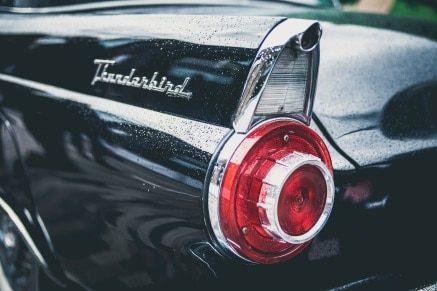
Standard auto insurance is based on actual cash value and depreciation. Meaning the older your vehicle is, the less it is worth. On the other hand, collector car insurance protects the vehicle for the full agreed value. This means it covers these desirable cars and trucks for their increased worth. Just like regular car insurance, collector auto policies offer the same coverage options: liability, collision and comprehensive, and medical pay — while also paying the full value of the vehicle that you and your insurance provider have agreed to if the worse should occur.
Here’s the best part. Collectible auto insurance usually costs less than standard auto insurance because classic and collector vehicles are normally driven less, are kept garaged. Plus, owners typically maintain them better; therefore, they are considered a better risk.
Collector car policies do come with restrictions:
- The vehicle must be stored in a locked, safe garage or storage facility
- The insured vehicle is at least 15 or 25 years old
- Limits on the miles it can be driven
- It is not used as a regular commute vehicle
- All drivers have a clean driving record
Some people don’t insure their collector vehicles because they store it or drive it so seldom, but that could be a big mistake. Classic car auto insurance pays the agreed value if the vehicle is damaged in a fire, flood, or during transportation, or if it is stolen. It also covers the higher cost of repairs if someone scratches the paint or chrome, or steals a specialty part.
Here are some important things to consider when purchasing collector car insurance:
- Choose a carrier that specializes in classic car coverage
- Pay attention to the fine print, exclusions and restrictions
- Maintain coverage when you are storing your vehicle
- Review your coverage each year to reflect any increase in value
There are many choices to insure your classic vehicle. California Casualty offers collector vehicle insurance through our partner, Condon Skelly. Unlike most classic insurance providers, Condon Skelly does not limit mileage or require seasonal coverage, while still offering competitive rates.

California Casualty is ready to help keep your beautiful baby protected and on the road. Contact one of our advisors today to arrange insurance for your classic or collectible car at 1.866.704.8614 or visit www.calcas.com/classic-car-insurance.
This article is furnished by California Casualty, providing auto and home insurance to educators, law enforcement officers, firefighters and nurses.
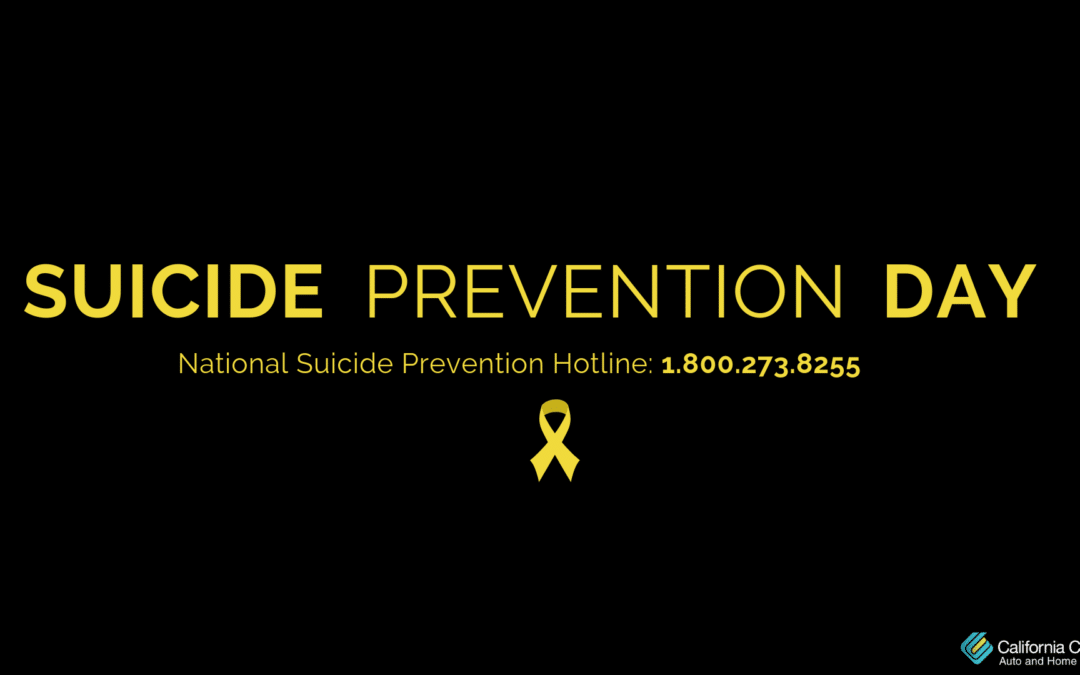
by California Casualty | Auto Insurance Info |
By Mark Goldberg, Communications Specialist with California Casualty
September 10th is World Suicide Prevention Day, and many people don’t like to talk about it, but it’s time to start.
The topic of suicide got a lot more personal for me four years ago when a good friend and retired firefighter, Tim Casey, took his life. Tim had written for the California Casualty blog about his life as a firefighter and the scars (both physical and mental) he carried from his 30 years as a first responder. His moving articles about mental health and PTSD in the fire service are real eye-openers.

I knew Tim had his struggles; he admitted that he was a recovering alcoholic, haunted by the things he saw on the job. He battled PTSD and the desire to drown those images in a bottle of booze, but on the outside, it appeared things were looking up for Tim. He was engaged to a wonderful woman, was very involved in spreading awareness about first responder suicides, and was teaching at one of the local universities. The last time I talked with Tim he seemed upbeat and happy, but I guess the demons were stronger than I or many others knew.
The Growing Problem of First Responder Suicide
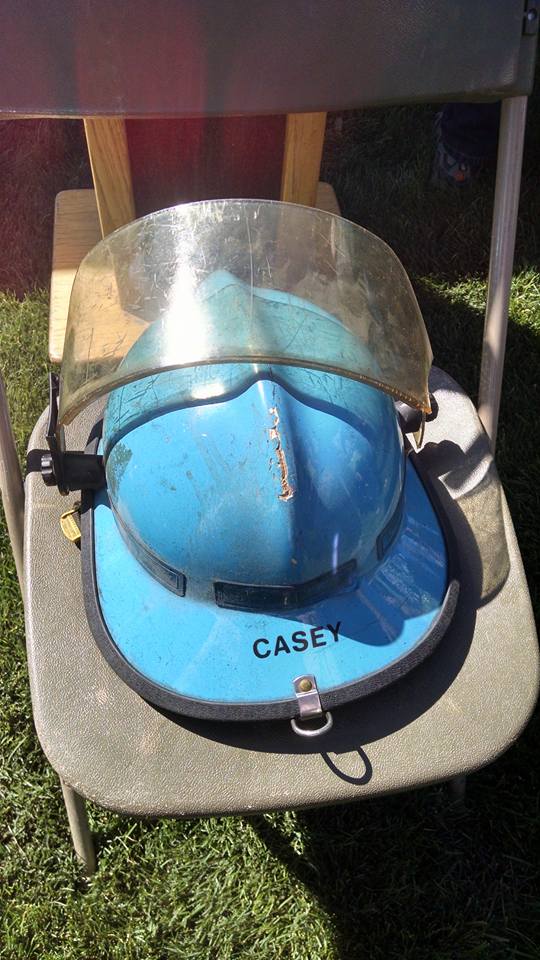 His funeral was moving, but it left me feeling sad and empty. I came away determined to do what I could to help carry on Tim’s mission to alert others about the growing epidemic of firefighter and first responder suicide. It’s a daunting task; the number of law enforcement and firefighter suicide deaths has now surpassed those who die in the line of duty.
His funeral was moving, but it left me feeling sad and empty. I came away determined to do what I could to help carry on Tim’s mission to alert others about the growing epidemic of firefighter and first responder suicide. It’s a daunting task; the number of law enforcement and firefighter suicide deaths has now surpassed those who die in the line of duty.
And that’s a problem; firefighter ranked second in CareerCast’s annual survey of the most stressful jobs for 2019, right after soldiers. Being a police officer ranked fourth on the list.
Both jobs are dangerous, with constant life-threatening situations and unspeakable tragedies. One can only imagine how the searing image of injury and trauma can impact a person.
The daily stress, combined with limited opportunities to talk about it, is taking a toll. 243 first responders committed suicide in 2018- and that number is only predicted to rise through 2019, with many others suffering PTSD. It’s a problem these professions can’t afford to ignore.
Help for First Responders
Suicide was a little-discussed topic by fire departments until Captain Jeff Dill created the Firefighter Behavioral Health Alliance (FBHA). Dill started the nonprofit after hearing about the emotional impact the World Trade Towers disaster had on firefighters in 2001 and talking with first responders about lack of mental health resources for those returning from the devastation of Hurricane Katrina in New Orleans. Captain Dill thinks the number of firefighter suicides that get reported is only the tip of the iceberg. He formally began the nonprofit in 2011 to directly educate firefighters/EMS personnel and their families about behavioral health issues, such as depression, PTSD, anxiety, and addictions – as well as firefighter suicides.
We recently had a chance to talk with Chief Dill about the FBHA and the mission of suicide prevention among the men and women who protect us. Dill also knew Tim Casey.
Tell us a little bit about yourself and FBHA.
I am a recently retired fire officer with over twenty-five years in the fire service, Master’s Degree in Counseling and founder of Firefighter Behavioral Health Alliance (FBHA). I can tell you from experience that looking into ourselves is very difficult.
FBHA is the only known organization that tracks and validates firefighter & EMT suicides in the U.S. We never use names or organizations unless families give us permission. We do take the known information and present workshops across N. America to educate our brothers and sisters.
How does FBHA reach out to Fire/EMS?
We help fire/ems departments learn how to recognize when a coworker is struggling and how to reach out to that person. We had two themes for our workshops until recently. The two were “Challenge With Compassion” and “Be Direct”. The premise was if you see someone struggling, acting different or hear things from them, then you need to Challenge with Compassion and Be Direct in your approach.
We know that people actually see us better than we see ourselves, so listen to them when they tell you “you’ve changed.” I have added the term that so many people have now heard this past year in our workshops, and that is we must do – an “Internal Size-Up”.
This simply means, what is going on in your life? Could these issues become monumental to the point that we become depressed, anxious, create suicidal ideations or become addicted to some type of vice? At times, we subconsciously begin to act in ways that only others can see. So when someone says to you “what is going on with you?” please do not take offense, take a look at your life!
Why is it so hard for first responders to ask for help?
In every workshop we deliver we talk about Traditional Brainwashing. This quite simply means we become a product of our training, experiences and historical beliefs. From our first days in either fire or EMS academies, we are taught everything to become confident and competent firefighters and EMT’s, yet, the greatest error is the lack of behavioral health.
The instructing of horrific things you will see and how they might play out in your life for a lifetime. The stress, anxiety, depression, sleep deprivation, PTSD and relationships that might go south leading to a high rate of divorce are all real issues we face yet never taught because it is a negative for our traditions! We are afraid to talk about it because we are taught not to.
When things are going rough for you then the greatest thing you can do for yourself is to listen. When people, who see us from a different point of view than ourselves, notice that something is different, then maybe it is time to look at our lives by performing an Internal Size-Up. This means seek professional help, talk to a chaplain, peer support or just a friend.
We, in the fire and EMS service, must remember we are human beings first. We are performing to standards that the general public will never understand. We are seeing things the general public will never see. So listen to others because maybe they are seeing things in us we will never see!
Stay safe!

Jeff Dill, Founder of Firefighter Behavioral Health Alliance – NPO (FBHA)
Thank you, Chief Dill, for your time.
Resources for First Responders in Crisis
So, what can we do? First, take the time to ask questions and offer help to a first responder who appears to be stressed, depressed or hurting. In one of his articles for California Casualty, Tim said if someone had really taken the time to press him, to ask him what he was feeling, he probably would have cracked and exposed his hurt. The sad truth is, maybe Tim or a first responder you know, was one conversation away from still being here with us.
More and more resources are being created to help first responders deal with and talk about the stresses of their jobs. The Firefighter Behavioral Health Alliance is a great first step, with information and links to support agencies. Other groups are now offering help for first responders in crisis:
- Safe Call Now – providing a confidential, comprehensive 24-hour crisis referral service for public safety members, 206-459-3020, safecallnow.org
- HelplineEmergency Ministries – providing chaplains for first-responder counseling and support, emergencychaplain.org
- Rosecrance Florian Program – offering substance abuse treatment and PTSD support for uniformed personnel, https://rosecrance.org/addiction-treatment/florian-program/
- NVFC Fire/EMS Helpline, 1-888-731-FIRE
- American Academy of Experts in Trauma Stress – collaborating with organizations to meet the needs of victims and survivors, aaets.org
- The Code Green Campaign – advocating for mental health awareness and education for first responders on how to provide care for themselves and their peers and reduce the stigma preventing people from admitting they have a problem and not seeking help, https://codegreencampaign.org
- Blue H.E.L.P – dedicated to reducing mental health stigma through education, advocate for benefits for those suffering from post-traumatic stress, acknowledge the service and sacrifice of law enforcement officers lost to suicide, assist officers in their search for healing, and bring awareness to suicide and mental health issues, https://bluehelp.org/
The goals of organizations like these is to raise awareness of the problem, end the stigma, and to find support for every firefighter and first-responder in need. But, if we don’t talk about the problem, we can’t solve it.
If you know a first responder, maybe someone you love, start the discussion. Ask them what they are feeling, how they are dealing with the stress of the job, and offer help. If you’re thinking there’s not a good time to bring up the subject, remember that this is also Suicide Prevention and Awareness Month. Too many good men and women, our protectors, are ending up as statistics in the battle against suicide.
If you or someone you love is having depressed or suicidal thoughts call the National Suicide Prevention Hotline at 1.800.273.8255.

by California Casualty | Auto Insurance Info, Pets, Safety |
Our pets are precious members of the family. We take them on adventures and shower them with treats and love. However, when it comes to disaster situations, our fur babies are often an after-thought, and sadly, many suffer and are left behind when a natural disaster hits.

September is National Preparedness Month. Each year we are reminded to prepare ourselves for emergency disasters in our home and communities. So, while you get your emergency plans in place, don’t forget to include your animals!
Take these actions and precautions before a calamity strikes to put your mind at ease and save your pet’s life.
- Have an evacuation plan that includes your pet and it’s necessities. Include food, leash, medications, a blanket (with your scent), water, and copies of vet records and vaccinations.
- Bring your pet inside. If you need to evacuate, have a crate or duffel on hand that you can easily transport them in.
- Place a rescue alert sticker on home door or window. This should be visible to rescuers, in case you are unable to get home. Available online, at pet stores, veterinarians, or from the ASPCA.
- Microchip your pets and update collar tags. Make sure the microchip is registered and up-to-date with your current information.
- Keep in mind many evacuation shelters do not take pets. Research pet-friendly hotels, shelters, and family/friends who will take in you and your pet in a disaster.
- Carry recent pictures of your pet. In case you get separated, keep a good photo of them sitting and standing for size/coat reference.

Having a disaster preparation plan in place for your pets will play a key role in saving their life in the event of an emergency. If you need help putting a plan in place, contact BringFido’s Canine Concierge. They will contact hotels and shelters across the nation to help you find somewhere for your pet. Plus, they will even give you advice on disaster preparation for pets!
Remember, pets can sense anxiety and become nervous, especially during high stress times like emergencies. It is important to give them TLC and let them know they will be ok.
This article is furnished by California Casualty, providing auto and home insurance to educators, law enforcement officers, firefighters, and nurses. In the event of a disaster know you and your pet are taken care of by adding Pet Insurance by Pets Best to your existing California Casualty policy and save up to 90% on all emergency vet bills. Get a quote at 1.866.704.8614 or www.calcas.com.
For more information visit:
https://bit.ly/34xLENY
https://bit.ly/34qK2Ft
https://bit.ly/2MTAldi
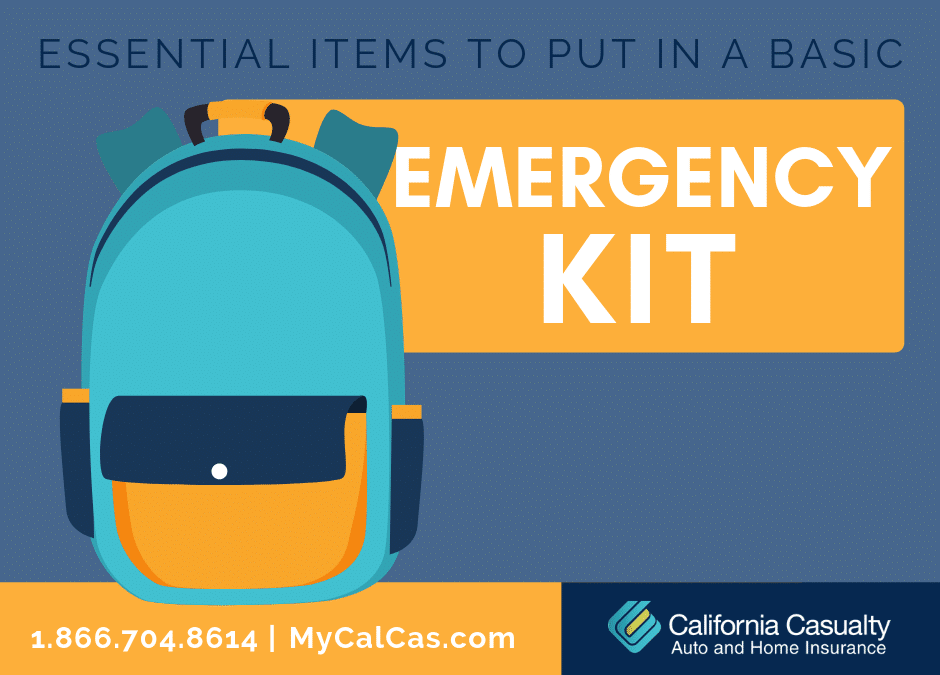
by California Casualty | Auto Insurance Info, Safety |
When an emergency or natural disaster strikes, it’s important to have an emergency preparedness kit stocked and ready to go with basic items that meet your family’s particular needs. Building an emergency kit is quick and easy. Plus, it could save your life.
It is recommended that you pack enough items to last you (and each member of your family) at least 72 hours. Start with a sturdy backpack or duffel bag that can hold days worth of supplies. Be sure to put non-waterproof items going into your kit in air-tight plastic bags before putting them in your backpack or duffel. Below is a complete list of basic items that should be in your emergency kit and additional items that you could add based on your families needs.
Basic Items for Your Emergency Kit:
- Non-Perishable Food Items
- Toilet Paper
- Bottled Water
- First Aid Kit
- Personal Medications.
- Flashlight
- Cash & Credit Cards
- Multi-Tool with a Can Opener
- Wrench or Pliers Kit (to turn off gas/water lines)
- Extra Clothing.
- Blankets
- Disinfectant Wipes
- Matches or Lighters
- Important Documents (ex. deed/lease, passport, birth certificate, insurance policy, emergency contact information)
- Whistle (in case you get trapped).
- Batteries
- Extra Keys
- Extra Chargers
- Battery Powered NOAA Weather Radio
- Feminine Hygiene Products.
Download our Basic Emergency Kit Checklist Below:
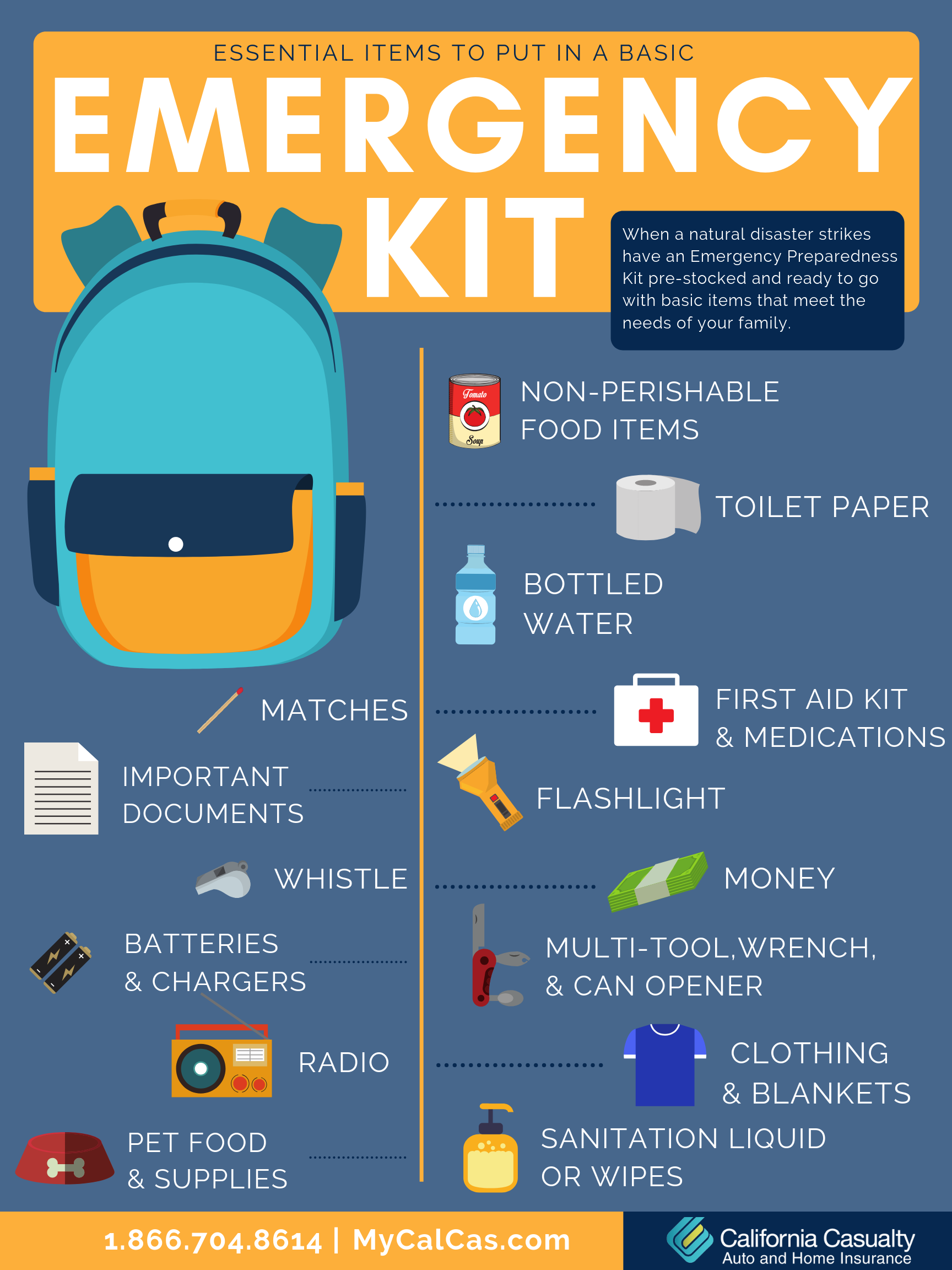
Additional Items for Your Emergency Kit:
- Pet Food & Supplies (food, litter, collars/leashes)
- Baby Supplies (formula, diapers, rash cream).
- Non-Prescription Medication
- Liquid Bleach (to disinfect water and/or cuts).
- Paper/Plastic Cutlery
- Books & Board Games
- Rain Gear (umbrellas, ponchos, jackets)
- Work Gloves.
- Extra Set of Glasses
- Extra Shoes
- Scissors
- Maps.
Once you have your emergency kit assembled, put it in a secure, easy to reach spot inside your home. Be sure other members of your household are aware of the location of the safety kit. You should check your kit every 6 months to make sure all of your items are up-to-date and not expired.
This article is furnished by California Casualty. Get a quote by calling 1.800.800.9410 or visit www.calcas.com.
For more information please visit:
https://bit.ly/34kHvNi
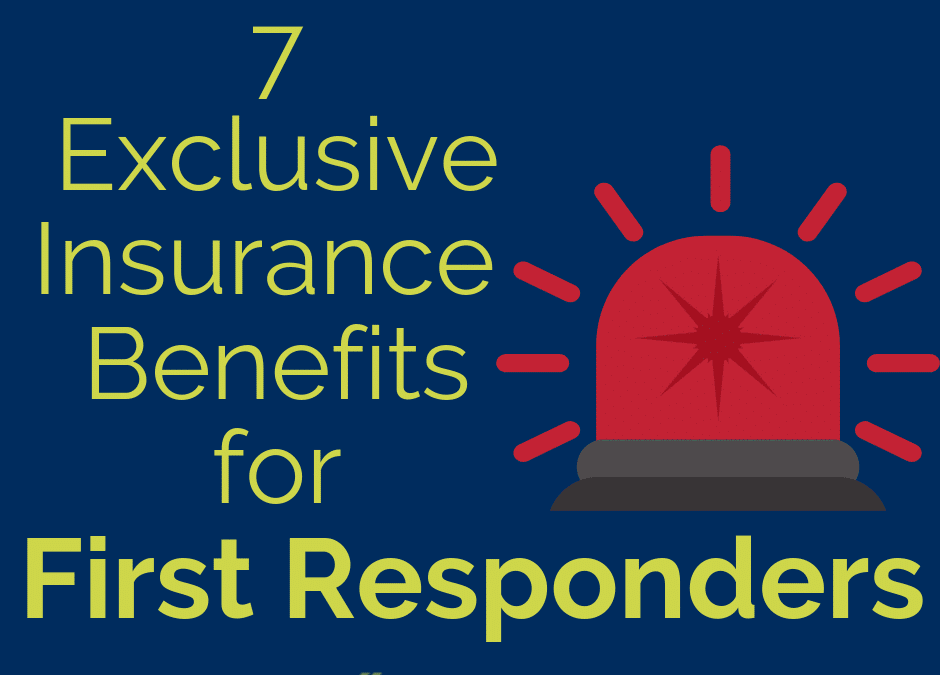
by California Casualty | Auto Insurance Info, Homeowners Insurance Info |
Being a first responder takes a lot of dedication, time, and training. You shouldn’t have to worry whether you have the right auto and home insurance. That’s why law enforcement and fire organizations have worked with California Casualty for decades to provide auto and home insurance to their members with exclusive benefits that are not available to the general public.
Here are 7 exclusive benefits for first responders from California Casualty:
- Waived Deductibles- California Casualty reduces the deductible up to $500 if your vehicle is vandalized or hit when parked where you work as a first responder.
- Personal Items in Your Vehicle- California Casualty includes $500 coverage for personal property (including turnout gear, safety equipment, and personal off-duty firearms) stolen from or damaged in your vehicle.
- Fallen Hero Benefit- California Casualty waives the insurance premium for the current year and the following year for the surviving spouse or partner of an insured firefighter or law enforcement officer who dies in the line of duty (not available in GA, MT, NH, TN and TX).
- Identity Protection- Each policy with California Casualty comes with FREE ID Theft protection and resolution services from CyberScout.
- Flexible Payment Options- Whether you like to pay one bill or do monthly installments, California Casualty lets you choose what works best for you. They also offer summer or holiday skip payment options so you can maximize your budget for the times when you need the money for other things.
- Insurance for Your Pets- Every auto insurance policy automatically includes up to $1,000 for vet bills if your pet is injured in a covered loss in your vehicle. California Casualty’s partner, Pets Best, also offers reduced rates for pet health insurance.
- Custom Parts and Accessories- California Casualty covers up to $2,000 for things you’ve added to your truck or van like custom rims, roll bars and furnishings (including pickup bed liners and covers).
Firefighter and Peace Officer associations have partnered with California Casualty because they have auto and home insurance policies tailored to best fit the lives of first responders. Be sure that you have all the coverage you need with the exclusive discounts you deserve. Contact a California Casualty adviser for a no-hassle policy review today, 1.866.704.8614 or https://www.calcas.com.
*All coverages may not be available in all states. In the case of any loss, the policy terms and conditions will apply.
This article is furnished by California Casualty, providing auto and home insurance to educators, law enforcement officers, firefighters and nurses. Get a quote at 1.866.704.8614 or www.calcas.com.







 His funeral was moving, but it left me feeling sad and empty. I came away determined to do what I could to help carry on Tim’s mission to alert others about the growing epidemic of firefighter and first responder suicide. It’s a daunting task; the number of law enforcement and firefighter
His funeral was moving, but it left me feeling sad and empty. I came away determined to do what I could to help carry on Tim’s mission to alert others about the growing epidemic of firefighter and first responder suicide. It’s a daunting task; the number of law enforcement and firefighter 





